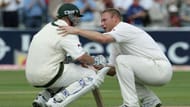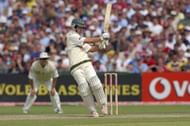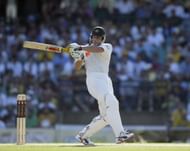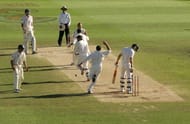More than ten years have passed since the greatest cricket video game of all time- EA Cricket 07 was released. The franchise came to an unfortunate and abrupt closure as EA Games decided against developing a new version, citing problems of piracy and lack of worldwide popularity. But the game has lived on, with the numerous patch-ups developed by ardent fans time to time.
The most interesting game mode was the Ashes, with the 2005 N-Power Ashes Scenarios being the highlight. Gamers could choose to play as either side, reliving moments of arguably the best Test series of all time, creating or rewriting the history as they advance. In this throwback article, let us reminisce the campaign from Australia's viewpoint. Get ready for a trip down the memory lane!
1st Test (Lord's):
#1. A Spark from Clarke:
After some egregious batting from both teams in the first innings, Australia is slowly building up on the slender lead by a cautious batting performance. The score is 188/3 and Michael Clarke is at 46 in the company of Damien Martyn. The objective is to compile his maiden Test century without running any batsman out. Given that there was no limit to the balls faced and no concerns about the other batsman's fate, this was a relatively simpler task.
Looking for Crossword hints & solutions? Check out latest NYT Mini Crossword Answers, LA Times Crossword Answers, and Atlantic Crossword Answers
What actually happened: Clarke was denied a well-deserved century when he was castled by Matt Hoggard on 91. But his performance played the pivot to set an improbable target for England, to which they had no answers.
#2. McGrath strikes back:

Post getting bowled out for a paltry 190 in the first innings, Australia required some early inroads to stay alive in the game. The onus was on The Pidge as the experienced duo of Marcus Trescothick and Andrew Strauss took guard. The objective is to take one wicket with McGrath. Another simple task, given that one could take any number of overs to complete it.
What actually happened: McGrath was phenomenal with the new ball as he sent half of the English order back into the hut with 21 runs on board. But for debutant Kevin Pietersen's fighting half-century, England would not have crossed even 100. Eventually, they folded up for 155, conceding strategic first innings lead to the Aussies.
2nd Test (Edgbaston):
#3. The Warne and Lee show:

Australia has conceded a vital first innings lead of 99 runs. They need to restrict England to a small total to have any realistic chances of winning the match. Ponting opts for a bowling change, replacing Michael Kasprowicz with Shane Warne, hoping that a combination of speed and spin would unsettle the opening duo.
England is at 25/0 and you need to take two wickets with Brett Lee and one with Shane Warne before the 50th over. Slightly difficult task compared to the first two, but the wet pitch makes it easier.
What actually happened: Warne and Lee wrecked havoc, as they shared all ten wickets between them. The former struck almost immediately as he broke through the defence of Strauss. From there, barring the lone-man battle of Andrew Flintoff, it was Warne and Lee all the way.
#4. Slim Chance for Victory:

The one with the best backstory of them all. After folding up England for 182, Australia needs to score 282 to win. A spirited performance by English bowlers has cornered them at 177-8. The last recognized batsman, Michael Clarke was yorked by Steve Harmison and just two runs have been scored after that. Brett Lee and Shane Warne are at the crease with 105 more required to win. Both have half-decent batting stats, but as the last man, Michael Kasprowicz is almost a mug with the bat, the task at hand is fairly tricky.
What actually happened: Need I explain this? The two marauders kept the scoreboard ticking with some belligerent batting. Though Warne departed midway, Lee took matters into his own hands as he smacked bowlers around the park. Kasprowicz also played a useful hand, as England started panicking. Close appeals, short balls, some vicious stares and unfortunate missed catches.., the audience were in for a treat. But with just three more required, Harmison delivered a gem of a short ball. Did Casper glove it..? Or was it the pads..? No one knows for sure but as Billy Bowden's crooked finger rose up, England was on cloud nine with Australians, at the depth of despair.
3rd Test (Old Trafford):
#5. Avoiding the follow-on:

England has racked up 444 in the first innings. In reply, Australia is at 186-6. An injured Michael Clarke walks in as they are in danger of following on. The task is to avoid that and score 90 runs with Shane Warne, who looks like he is carrying on his handy form with the bat from the previous match. Also, you should not run any batsman out. Avoiding follow-on is a fairly simple task as even when injured, Michael Clarke can bat as well as he always does once he survives a few deliveries!
What actually happened: Michael Clarke couldn't do anything. It was a calculated innings of 90 from Shane Warne and some defiant defending by Jason Gillespie (for which he is notorious for) that helped Australia save the blushes as they reached 302, still conceding a sizable lead.
#6. Ponting on the prowl:

Riding on Andrew Strauss' century and some lusty blows from Geraint Jones down the order, England set an uphill target of 423 for the Aussies. With a little over a day remaining, England would have been hopeful of a victory. Australia is now 135-3, and Ricky Ponting looks well set on 48. Whether it is saving the match or going for a win, a captain's knock from him would be instrumental in it. The task is to score 150 runs with Ponting. This is also an easy task, given Ponting is among the top 5 best batsmen in the game.
What actually happened: The Punter was on a roll that day, dispatching every bowler with utter disdain. In fact, if he had an aorta of support from any of his teammates, Australia may have pulled off the chase. Once he ran out of recognized batting partners, Ponting calmly switched down the gears, absorbing the pressure. He was the penultimate one to fall, nicking one off Steve Harmison at 156. England sniffed victory whereas, for Australia, it was almost a deja vu of the previous Test. They were almost at the receiving end of another heartbreak, but the nervous duo of Glen McGrath and Brett Lee held on to their nerves for the remaining 24 balls, ensuring the captain's knock did not go in vain.
4th Test (Trent Bridge):
#7. Australia in trouble:

Just like the previous Test, the Australian top order has collapsed miserably. Michael Clarke has just walked back and Australia are five down with hundred on board. As Adam Gilchrist joins Simon Katich the middle, Australia needs to score 178 more runs to avoid the follow-on. The task is not too difficult, as the player would already have the experience of pulling off something even harder with Lee and Warne. Here, they have two recognized batsmen in the crease which should have made the task easier in reality also.
What actually happened: This time, Australia could not escape the humiliation as they got skittled out for 218. After a brief resistance from the pair, the tail end collapsed in a flurry as none except Brett Lee had answers to a rampaging Simon Jones who ended up with another 5 wicket haul.
#8. One last chance for victory:

A much-improved performance from the top order in an embarrassing follow-on saw Australia setting up an unremarkable target of 129 for the visitors. What should have been a straightforward chase has got messed up, as every batsman in the top order squandered good starts. As the last batsman Geraint Jones holes out one to Michael Kasprowicz, England still need 13 to win with three wickets in hand. The task is simple- Win the Test for Australia.
What actually happened: Though Australia put up more than a fight, the English lower order was a bit too defiant. Or rather, the Australian redemption was a bit too late. 13 runs is not a huge task by any standards, and the pair of Matt Hoggard and Ashley Giles played sensibly, knocking the ball around and reaching the target without any further fuss.
5th Test (The Oval)
#9. Better late than never:

One main reason for Australia conceding a 2-1 lead after four fixtures is the failure of the openers. Another failure would definitely mean the end of the road for them. England has put a decent total on board and the onus is now on Justin Langer and Mathew Hayden. The task is to score a hundred with Langer and to put up a partnership of 185 runs. This is a fairly difficult task, as scoring 185 runs without losing a wicket would need a mix of caution and aggression.
What actually happened: The pair batted with purpose, piling up runs steadily to stake their claims to their current positions in the team. Both went on to score individual hundreds, but none else could contribute significantly as Australia lost their last seven for just 44, conceding a slender lead of 6 runs. A combination of this lower order collapse and bad weather conditions made England rethink their strategies, which ultimately eliminated any chance Australia had to square the series.
#10. What if?

My personal favourite, and the hardest task of them all. Australia needs to chase down a target of 342 from a maximum of 15 overs in the final session. Yes, the required run rate is almost 23 per over. To win this, you have to continually execute the six hitting strategy to perfection!
But it is possible to find a way around. If you save the game after the first over following tea break and load the game again, the game will again start from the tea break. Voila, you have accessed an extra over in the game. Use this strategy to perfection, and you can squeeze out as many overs as you want to, which makes the task a hell lot easier!
What actually happened: Nothing! As bad light stopped play just after four balls being bowled in the fourth innings, Australia lost possession of the urn and England reclaimed it, after a gap of 16 years in arguably the greatest and most closely fought test series of all time.
Follow IPL Auction 2025 Live Updates, News & Biddings at Sportskeeda. Get the fastest updates on Mega-Auction and cricket news
